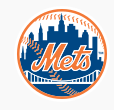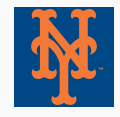
| New York Mets | |||||
| 2013 New York Mets season | |||||
| Established | 1962 | ||||
|
|||||
| Major league affiliations | |||||
|
National League (1962–present) National League East (1969–present) |
|||||
| Current uniform | |||||
|
|||||
| Retired numbers | 14 · 37 · 41 ·42 · Shea | ||||
| Colors | |||||
|
Blue, orange, & white |
|||||
| Name | |||||
| New York Mets (1962–present) | |||||
| Other nicknames | |||||
| The Amazin's, The Metropolitans, The Miracle Mets (1969) | |||||
| Ballpark | |||||
|
Citi Field (2009–present) Shea Stadium (1964–2008) Polo Grounds (1962–1963) |
|||||
| Major league titles | |||||
| World Series titles (2) | 1986 · 1969 | ||||
| NL Pennants (4) | 2000 · 1986 ·1973 · 1969 | ||||
| East Division titles (5) | 2006 · 1988 ·1986 · 1973 · 1969 | ||||
| Wild card berths (2) | 2000 · 1999 | ||||
| Front office | |||||
| Owner(s) | Fred Wilpon | ||||
| Manager | Terry Collins | ||||
| General Manager | Sandy Alderson | ||||
| President of Baseball Operations | Saul Katz | ||||
The New York Mets are a professional baseball team based in the borough of Queens in New York City. They belong to Major League Baseball's National League East Division. One of baseball's first expansion teams, the Mets were founded in 1962 to replace New York's departed National League teams, the Brooklyn Dodgers and New York Giants. The Mets colors are composed of the Dodgers blue and Giants orange. During the 1962 and 1963 seasons, the Mets played their home games at the Polo Grounds. From 1964 to 2008, the Mets' home ballpark was Shea Stadium. In 2009, they moved into a new ballpark, Citi Field.
In their 1962 inaugural season, the Mets posted a record of 40–120, the worst regular season record since Major League Baseball went to a 162-game season (two games from their inaugural season were never made up). The team never finished better than second to last until the 1969 "Miracle Mets" beat the Baltimore Orioles in the 1969 World Series in what is considered one of the biggest upsets in World Series history.[1] Since then, they have played in three additional World Series, including a dramatic run in 1973 that ended in a Game Seven loss to the Oakland Athletics, a second championship in 1986 against the Boston Red Sox that was cited in the Curse of the Bambino, and a Subway Series against their cross-town rivals the New York Yankees in the2000 World Series which they lost in five games.
In the previous decade the Mets made one playoff appearance after the 2000 season; it was in 2006 when they came within one game of the World Series, losing to the eventual World Champion St. Louis Cardinals in Game 7 of the 2006 National League Championship Series. The Mets missed the playoffs on the last day of the regular season in 2007 and 2008 and have finished with losing records every year since. In 2010, the Mets hired a new general manager, Sandy Alderson, and a new manager, Terry Collins.
Franchise history
Main article: History of the New York Mets
In 1957, the Brooklyn Dodgers and New York Giants relocated from New York to California to become the Los Angeles Dodgers and San Francisco Giants, respectively, leaving the largest city in the United States with no National League franchises and only one Major League team (the New York Yankees). With the threat of a New York team in a third league, the National League expanded, adding the New York Mets. The new team took as its primary colors the blue of the Dodgers and the orange of the Giants (which are conveniently two of the three colors on the New York City flag), and took their name from the original 19th century New York Metropolitans club.[2]
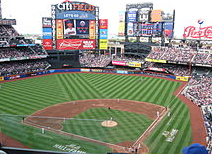
The Mets current stadium, Citi Field
For the first two years of its existence, the team played its home games at the historic Polo Grounds in Upper Manhattan. In 1964, they moved into newly constructed Shea Stadium in Flushing Meadows, Queens, where the Mets stayed through the 2008 season. In 2009, the club moved into Citi Field, located adjacent to the former site of Shea Stadium.
During their history, the Mets have won two World Series titles (1969 and 1986), four National League pennants (1969, 1973, 1986, 2000) and five National League East titles (1969, 1973, 1986, 1988, 2006). The Mets also qualified for the postseason as the National League Wild Card team in 1999 and 2000. The Mets have appeared in more World Series—four—than any other expansion teamin Major League Baseball history. Their two championships equal the tally of the Toronto Blue Jays and Miami Marlins for the most titles among expansion teams.
The Mets held the New York baseball attendance record for 29 years. They broke the Yankees' 1948 record by drawing nearly 2.7 million in 1970. The Mets broke their own record five times before the Yankees took it back in 1999.[3][4]
The 1962 Mets posted a 40–120 record, one of the worst in major-league history, and the most losses in one season since 1899. In 1966, the Mets famously bypassed Hall of Famer Reggie Jacksonin the amateur draft, instead selecting Steve Chilcott, who never played in the majors. But the following year, they acquired future Hall of Famer Tom Seaver in a lottery. Seaver helped the1969 "Miracle Mets" win the new National League East division title, and then defeat the heavily-favored Baltimore Orioles to win the 1969 World Series.
In 1973, the Mets rallied from last place to win the division, despite a record of only 82–79. They shocked the heavily-favored Cincinnati Reds "Big Red Machine" in the NLCS and pushed the defending World Series Champion Oakland Athletics to a seventh game, but lost. This National League pennant was notable because it was the only NL East title between 1970 and 1980 that wasn't won by either the Philadelphia Phillies or the Pittsburgh Pirates.[5][6]
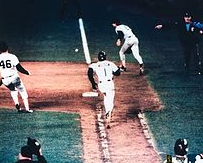
This famous photograph came from the famous Game 6 of the 1986 World Series. Ray Knight (not pictured) scores the winning run as Bill Buckner and Bob Stanley watch Mookie Wilson's slow roller.
Star pitcher Tom Seaver was traded in 1977, a day remembered in the sports world as "the Midnight Massacre," and the Mets fell into last place for several years. The franchise turned around in the mid-1980s. During this time the Mets also drafted slugger Daryl Strawberry (#1 in 1980) and 1984 Cy Young Award winner Doc Gooden (#5 in 1982). In addition Keith Hernandez, former National League MVP and perennial gold-glove winner was obtained by the Mets in 1983.
In 1985, they acquired Hall of Fame catcher Gary Carter from the Montreal Expos and won 98 games, but narrowly missed the playoffs. In 1986, they easily won the division with one of the best records of 108-54 in National League history. They won a dramatic NLCS in six games over the Houston Astros which they needed to win to avoid facing Mike Scott in Game 7. The NLCS game six win was sixteen innings long, the longest playoff game in history until the Braves and Astros went 18 innings in 2005. They came within one strike of losing the World Series against the Boston Red Sox before a series of hits and defensive miscues ultimately led to an error by Boston's Bill Buckner which gave the Mets a Game 6 victory. They then won Game 7 to win their second World Series.
The Mets continued playing well after 1986 and won the division in 1988, but lost the playoffs that year and declined into the 1990s. They were out of contention until the 1997 season when they narrowly missed the playoffs. In 1998, the Mets acquired Mike Piazza in a blockbuster trade and missed the 1998 postseason by only one game. In 1999, they made the playoffs in a one game playoff but lost the 1999 National League Championship Series to the Atlanta Braves. In 2000, they easily clinched a wild card spot in the playoffs, and earned a trip to the 2000 World Series against their crosstown rivals, the New York Yankees for a "Subway Series". The Mets were defeated by the Yankees in five games.
The Mets had a near playoff miss in 2001 and struggled in 2002, 2003 and 2004. In the aftermath of the 2004 season the Mets hired a new General Manager, Omar Minaya, who immediately turned the franchise around by signing Pedro Martinez and hiring a new manager, Willie Randolph. As a result, the Mets finished 2005 four games over the .500 mark. The Mets turnaround was complete in the 2006 season as they won 97 games and the NL East crown behind new acquisitions Carlos Beltran and Carlos Delgado, as well as young superstars Jose Reyes and David Wright. The Mets advanced to game seven of the 2006 NLCS but lost after Yadier Molina’s game-winning two-run home run in the top of the ninth inning. The Mets would load the bases with two outs in the bottom of the inning, but Adam Wainright struck out Carlos Beltran looking with a devastating curveball.
In 2007, the Mets entered the final 17 games in the season with a seven-game lead in the division. The Mets fell down in the standings throughout those games and needed to win their final two games of the season. The Mets won that Saturday, but on Sunday, Tom Glavine gave up seven runs in the first inning. The Mets managed only one run that day and were eliminated.
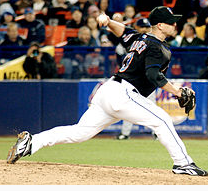
Billy Wagner pitching for the Mets in 2007.
The Mets held a more modest 3.5 game lead after 145 games of the 2008 season, their final season at Shea Stadium. While their 7–10 mark down the stretch was slightly better than the previous season's 5–12, it still allowed the Phillies to pass them, once again. The Mets opened Citi Field in 2009, but were not a factor due to a rash of injuries to numerous key players including, but not limited to, Jose Reyes, Carlos Beltran, Carlos Delgado, Oliver Perez and Livan Hernandez. The plague of injuries plummeted the Mets to a 70–92 record. The Mets did not fare any better in 2010, finishing with a losing record and missing the playoffs for the fourth straight year. The Mets finished with a 79–83 record, coming in fourth place in the National League East.
Upon the conclusion of the 2010 season, the Mets front office fired General Manager Omar Minaya and Manager Jerry Manuel. Former Oakland G.M. and MLB executive Sandy Alderson was hired to run the team. Alderson hired Terry Collins to replace Manuel as manager.
The Wilpon family and Saul Katz recently settled the lawsuit brought against them on behalf of the victims of Bernard Madoff’s Ponzi scheme for $162 Million. As a result of this agreement the liquidator,Irving Picard, agreed to drop the charges that the Wilpons and Mr. Katz blindly went along with the scheme for their personal benefit. Picard had originally sought to recover $1 Billion from the Wilpon family and Mr. Katz, but had to settle for $162 Million along with the admission that neither the Wilpons nor Mr. Katz had any knowledge of the Ponzi scheme. There were recently 12 4% shares (48%) to the team sold by the majority ownership group to provide a cash infusion for the team.
Despite yet another losing season, the Mets made history in 2011 when Jason Isringhausen converted his 300th save with the team, the third player in franchise history to reach the milestone while with the organization behind John Franco and Billy Wagner. Also, José Reyes became the first Met in franchise history to win a National League batting title with .337 batting average. In 2012, the Mets tried to bounce back from 3 consecutive losing seasons, but had a big hole to fill since the Mets lost José Reyes via free agency, when he signed a six year, $106 million contract with the Miami Marlins. The Mets started out strong, having a career years from the MLB's only knuckleballer, R.A. Dickey, and David Wright. But they faltered midseason and ended with a 74-88 record, 4th in the division.
Until June 1, 2012, no pitcher in Mets history had thrown a no-hitter, and the franchise's hurlers had gone 8,019 [7] games without pitching one—longer than any other Major League franchise. They were one of only two current Major League teams to never have a pitcher throw a no-hitter, the other being the San Diego Padres. Long time Mets ace Tom Seaver, who threw five one-hitters as a Met, eventually threw a no-hitter, but by then he was playing for the Cincinnati Reds. Similarly, the ace of the 1986 team, Dwight Gooden, threw his no-hitter for the Yankees (in 1996), and David Cone, who starred for the Mets from 1987–1992, threw a perfect game later in his career, also as a Yankee. The ultimate example of this trend is Hall of Famer Nolan Ryan, who started his career with the Mets, but threw a record seven no-hitters after leaving the club.
However, on June 1, 2012, Johan Santana pitched a no-hitter against the St. Louis Cardinals in an 8-0 victory. Averting the spotlight from Carlos Beltran's return to Citi Field, Santana turned a routine game into a moment in baseball lore and Mets history. Santana was risking being pulled after he went over his pitch cap of 110 pitches, placed by the team because of his shoulder surgery, throwing 134 pitches on the evening. Still Santana stayed in the game and with the help of a few great defensive plays as well as a controversial call of a foul ball, pulled off the first no-hitter in Mets history.[8]
Theme song
"Meet the Mets" is the Mets' signature song, written in 1961, one year before the first season, by Bill Katz and Ruth Roberts. It is played on the radio, during television broadcasts and at Mets' home games.[9]
Mascot
For more information, see Mr. Met.
Mr. Met is the official mascot of the New York Mets. He was first introduced on the cover of game programs in 1963, when the Mets were still playing at the Polo Grounds in northern Manhattan.[10] When the Mets moved to Shea Stadium in 1964, fans were introduced to a live costumed version.[10] Mr. Met is believed to have been the first mascot in Major League Baseball to exist in human (as opposed to artistically rendered) form.[10]
Uniform and logo symbolism
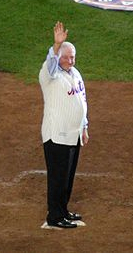
Jerry Koosmanwearing his mid-1960s era Mets jersey, which served as an inspiration for the current Mets pinstriped uniform.
For more information, see Logos and uniforms of the New York Mets.
The Mets' colors are blue and orange, originally chosen to honor the city's history of National League baseball; blue for the Brooklyn Dodgers, and orange for the New York Giants. Blue and orange are also the colors of New York City, as seen on its flag.
In 1998, black was officially added to the color scheme, although beginning with 2012 the black elements in the uniform began to be phased out, and was eliminated in 2013.
Logo
The cap logo is identical to the logo used by the New York Giants in their final years, and is on a blue cap reminiscent of the caps worn by the Brooklyn Dodgers. In the primary logo, designed by sports cartoonist Ray Gatto, each part of the skyline has special meaning—at the left is a church spire, symbolic of Brooklyn, the borough of churches; the second building from the left is the Williamsburgh Savings Bank, the tallest building in Brooklyn; next is the Woolworth Building; after a general skyline view of midtown comes the Empire State Building; at the far right is the United Nations Building. The bridge in the center symbolizes that the Mets, by bringing National League baseball back to New York, represent all five boroughs.[2]
With the introduction of black as an official color, an alternate team logo was created in 1999. It is identical to the original logo, but the skyline is black instead of blue and the "Mets" script is blue trimmed in orange and white instead of orange trimmed in white (the alternate black jerseys displayed the primary orange and blue logo on the left sleeves in 1998; in 1999 this was changed to the alternate black and blue logo). The logo fell into disuse after the Mets dropped the alternate black jerseys and caps in 2012.
Also in 1999, the logo received a slight alteration. The "NY" to the left of the team script was removed. No other notable changes were made.
Uniform color and design
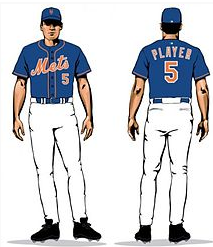
New York Mets home alternate uniform, 2013-present.
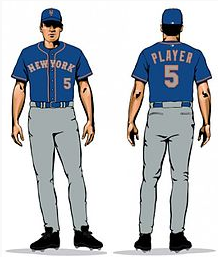
New York Mets road alternate uniform, 2013-present.
Currently, the Mets wear an assortment of uniforms.
On November 16, 2011, the Mets announced new uniforms for their 2012 season, as part of the unveiling of their 50th anniversary plans.[11] The primary change was the removal of black drop shadows from all of the team's jerseys, mirroring the team's original on-field look. The off-white pinstriped jersey, introduced as an alternate in 2010 and based on the team's original 1962-77 home uniform, is the primary home jersey while the plain-white jersey with blue placket and sleeve piping, first introduced in 1997, is now the home alternate. Both uniforms feature the "Mets" script, player numerals and names in blue outlined in orange, and both be worn with the team's traditional blue cap with orange crest (although the orange button on top of the cap has been retained), blue undersleeves, belts and socks.
The gray road jerseys feature a radially-arched "NEW YORK" script in Tiffany style, player numerals and names in blue outlined in orange, and blue placket and sleeve piping. Like the home uniforms, the road grays are worn with blue caps, undersleeves, belts and socks.
On November 14, 2012, the Mets introduced two new blue alternate jerseys. The home alternate features the "Mets" script, player numerals and names in orange outlined in white, while the road alternate feature the "NEW YORK" script, player numerals and names in gray outlined in orange.[12]
On December 10, 2012, the Mets unveiled an alternate blue fielding cap, featuring an orange brim and a white trim around the orange "NY" insignia. [13]
Minor league affiliations
| Level | Team | League | Location |
| AAA | Las Vegas 51s | Pacific Coast League | Las Vegas, Nevada |
| AA | Binghamton Mets | Eastern League | Binghamton, New York |
| Advanced A | St. Lucie Mets | Florida State League | Port St. Lucie, Florida |
| A | Savannah Sand Gnats | South Atlantic League | Savannah, Georgia |
| Short Season A | Brooklyn Cyclones | New York-Penn League | Brooklyn, New York |
| Rookie | Kingsport Mets | Appalachian League | Kingsport, Tennessee |
| GCL Mets | Gulf Coast League | Port St. Lucie, Florida | |
| DSL Mets 1 | Dominican Summer League | Boca Chica, Dominican Republic | |
| DSL Mets 2 | Dominican Summer League | Boca Chica, Dominican Republic |


